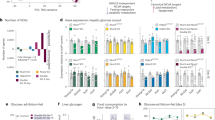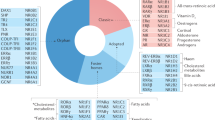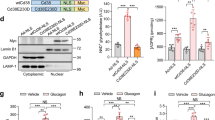Abstract
Hepatic glucose production is crucial for glucose homeostasis, and its dysregulation contributes to the pathogenesis of diabetes. Here, we show that members of the NR4A family of ligand-independent orphan nuclear receptors are downstream mediators of cAMP action in the hormonal control of gluconeogenesis. Hepatic expression of Nur77, Nurr1 and NOR1 is induced by the cAMP axis in response to glucagon and fasting in vivo and is increased in diabetic mice that exhibit elevated gluconeogenesis. Adenoviral expression of Nur77 induces genes involved in gluconeogenesis, stimulates glucose production both in vitro and in vivo, and raises blood glucose levels. Conversely, expression of an inhibitory mutant Nur77 receptor antagonizes gluconeogenic gene expression and lowers blood glucose levels in db/db mice. These results outline a previously unrecognized role for orphan nuclear receptors in the transcriptional control of glucose homeostasis.
This is a preview of subscription content, access via your institution
Access options
Subscribe to this journal
Receive 12 print issues and online access
$209.00 per year
only $17.42 per issue
Buy this article
- Purchase on Springer Link
- Instant access to full article PDF
Prices may be subject to local taxes which are calculated during checkout





Similar content being viewed by others
References
Saltiel, A.R. & Kahn, C.R. Insulin signalling and the regulation of glucose and lipid metabolism. Nature 414, 799–806 (2001).
DeFronzo, R.A., Bonadonna, R.C. & Ferrannini, E. Pathogenesis of NIDDM. A balanced overview. Diabetes Care 15, 318–368 (1992).
Saltiel, A.R. New perspectives into the molecular pathogenesis and treatment of type 2 diabetes. Cell 104, 517–529 (2001).
Trinh, K.Y., O'Doherty, R.M., Anderson, P., Lange, A.J. & Newgard, C.B. Perturbation of fuel homeostasis caused by overexpression of the glucose-6-phosphatase catalytic subunit in liver of normal rats. J. Biol. Chem. 273, 31615–31620 (1998).
Valera, A., Pujol, A., Pelegrin, M. & Bosch, F. Transgenic mice overexpressing phosphoenolpyruvate carboxykinase develop non-insulin-dependent diabetes mellitus. Proc. Natl. Acad. Sci. USA 91, 9151–9154 (1994).
Pilkis, S.J. & Granner, D.K. Molecular physiology of the regulation of hepatic gluconeogenesis and glycolysis. Annu. Rev. Physiol. 54, 885–909 (1992).
Montminy, M. Transcriptional regulation by cyclic AMP. Annu. Rev. Biochem. 66, 807–822 (1997).
Montminy, M., Koo, S.H. & Zhang, X. The CREB family: key regulators of hepatic metabolism. Ann. Endocrinol. (Paris) 65, 73–75 (2004).
Herzig, S. et al. CREB regulates hepatic gluconeogenesis through the coactivator PGC-1. Nature 413, 179–183 (2001).
Yoon, J.C. et al. Control of hepatic gluconeogenesis through the transcriptional coactivator PGC-1. Nature 413, 131–138 (2001).
Koo, S.H. et al. The CREB coactivator TORC2 is a key regulator of fasting glucose metabolism. Nature 437, 1109–1111 (2005).
Lin, J. et al. Defects in adaptive energy metabolism with CNS-linked hyperactivity in PGC-1α null mice. Cell 119, 121–135 (2004).
Zhang, L., Rubins, N.E., Ahima, R.S., Greenbaum, L.E. & Kaestner, K.H. Foxa2 integrates the transcriptional response of the hepatocyte to fasting. Cell Metab. 2, 141–148 (2005).
Puigserver, P. et al. Insulin-regulated hepatic gluconeogenesis through FOXO1-PGC-1α interaction. Nature 423, 550–555 (2003).
Wang, Z. et al. Structure and function of Nurr1 identifies a class of ligand-independent nuclear receptors. Nature 423, 555–560 (2003).
Baker, K.D. et al. The Drosophila orphan nuclear receptor DHR38 mediates an atypical ecdysteroid signaling pathway. Cell 113, 731–742 (2003).
Philips, A. et al. Novel dimeric Nur77 signaling mechanism in endocrine and lymphoid cells. Mol. Cell. Biol. 17, 5946–5951 (1997).
Wilson, T.E., Fahrner, T.J., Johnston, M. & Milbrandt, J. Identification of the DNA binding site for NGFI-B by genetic selection in yeast. Science 252, 1296–1300 (1991).
Winoto, A. & Littman, D.R. Nuclear hormone receptors in T lymphocytes. Cell 109, Suppl, S57–S66 (2002).
Pei, L., Castrillo, A., Chen, M., Hoffmann, A. & Tontonoz, P. Induction of NR4A orphan nuclear receptor expression in macrophages in response to inflammatory stimuli. J. Biol. Chem. 280, 29256–29262 (2005).
Milbrandt, J. Nerve growth factor induces a gene homologous to the glucocorticoid receptor gene. Neuron 1, 183–188 (1988).
Woronicz, J.D., Calnan, B., Ngo, V. & Winoto, A. Requirement for the orphan steroid receptor Nur77 in apoptosis of T-cell hybridomas. Nature 367, 277–281 (1994).
Liu, Z.G., Smith, S.W., McLaughlin, K.A., Schwartz, L.M. & Osborne, B.A. Apoptotic signals delivered through the T-cell receptor of a T-cell hybrid require the immediate-early gene nur77. Nature 367, 281–284 (1994).
Zetterstrom, R.H. et al. Dopamine neuron agenesis in Nurr1-deficient mice. Science 276, 248–250 (1997).
Saucedo-Cardenas, O. et al. Nurr1 is essential for the induction of the dopaminergic phenotype and the survival of ventral mesencephalic late dopaminergic precursor neurons. Proc. Natl. Acad. Sci. USA 95, 4013–4018 (1998).
Maxwell, M.A. et al. Nur77 regulates lipolysis in skeletal muscle cells. Evidence for cross-talk between the beta-adrenergic and an orphan nuclear hormone receptor pathway. J. Biol. Chem. 280, 12573–12584 (2005).
Kovalovsky, D. et al. Activation and induction of NUR77/NURR1 in corticotrophs by CRH/cAMP: involvement of calcium, protein kinase A, and MAPK pathways. Mol. Endocrinol. 16, 1638–1651 (2002).
Koo, S.H. et al. PGC-1 promotes insulin resistance in liver through PPAR-α–dependent induction of TRB-3. Nat. Med. 10, 530–534 (2004).
Shepherd, P.R. & Kahn, B.B. Glucose transporters and insulin action–implications for insulin resistance and diabetes mellitus. N. Engl. J. Med. 341, 248–257 (1999).
Rhee, J. et al. Regulation of hepatic fasting response by PPARγ coactivator-1alpha (PGC-1): requirement for hepatocyte nuclear factor 4α in gluconeogenesis. Proc. Natl. Acad. Sci. USA 100, 4012–4017 (2003).
Arkenbout, E.K. et al. Protective function of transcription factor TR3 orphan receptor in atherogenesis: decreased lesion formation in carotid artery ligation model in TR3 transgenic mice. Circulation 106, 1530–1535 (2002).
Spiegelman, B.M. & Heinrich, R. Biological control through regulated transcriptional coactivators. Cell 119, 157–167 (2004).
Conkright, M.D. et al. Genome-wide analysis of CREB target genes reveals a core promoter requirement for cAMP responsiveness. Mol. Cell 11, 1101–1108 (2003).
Law, S.W., Conneely, O.M., DeMayo, F.J. & O'Malley, B.W. Identification of a new brain-specific transcription factor, NURR1. Mol. Endocrinol. 6, 2129–2135 (1992).
Ohkura, N., Hijikuro, M., Yamamoto, A. & Miki, K. Molecular cloning of a novel thyroid/steroid receptor superfamily gene from cultured rat neuronal cells. Biochem. Biophys. Res. Commun. 205, 1959–1965 (1994).
Murphy, E.P. & Conneely, O.M. Neuroendocrine regulation of the hypothalamic pituitary adrenal axis by the nurr1/nur77 subfamily of nuclear receptors. Mol. Endocrinol. 11, 39–47 (1997).
Fahrner, T.J., Carroll, S.L. & Milbrandt, J. The NGFI-B protein, an inducible member of the thyroid/steroid receptor family, is rapidly modified posttranslationally. Mol. Cell. Biol. 10, 6454–6459 (1990).
Erion, M.D. et al. MB06322 (CS-917): A potent and selective inhibitor of fructose 1,6-bisphosphatase for controlling gluconeogenesis in type 2 diabetes. Proc. Natl. Acad. Sci. USA 102, 7970–7975 (2005).
Wansa, K.D., Harris, J.M., Yan, G., Ordentlich, P. & Muscat, G.E. The AF-1 domain of the orphan nuclear receptor NOR-1 mediates trans-activation, coactivator recruitment, and activation by the purine anti-metabolite 6-mercaptopurine. J. Biol. Chem. 278, 24776–24790 (2003).
Ordentlich, P., Yan, Y., Zhou, S. & Heyman, R.A. Identification of the antineoplastic agent 6-mercaptopurine as an activator of the orphan nuclear hormone receptor Nurr1. J. Biol. Chem. 278, 24791–24799 (2003).
Xu, J. et al. Peroxisome proliferator-activated receptor α (PPARα) influences substrate utilization for hepatic glucose production. J. Biol. Chem. 277, 50237–50244 (2002).
Szafranek, J., Pfaffenberger, C.D. & Horning, E.C. The mass spectra of some per-O-acetylaldononitriles. Carbohydr. Res. 38, 97–105 (1974).
Katz, J., Lee, W.N., Wals, P.A. & Bergner, E.A. Studies of glycogen synthesis and the Krebs cycle by mass isotopomer analysis with [U-13C]glucose in rats. J. Biol. Chem. 264, 12994–13004 (1989).
Lee, W.N., Byerley, L.O., Bergner, E.A. & Edmond, J. Mass isotopomer analysis: theoretical and practical considerations. Biol. Mass Spectrom. 20, 451–458 (1991).
Laffitte, B.A. et al. Activation of liver X receptor improves glucose tolerance through coordinate regulation of glucose metabolism in liver and adipose tissue. Proc. Natl. Acad. Sci. USA 100, 5419–5424 (2003).
Tontonoz, P. et al. Adipocyte-specific transcription factor ARF6 is a heterodimeric complex of two nuclear hormone receptors, PPAR γ and RXR α. Nucleic Acids Res. 22, 5628–5634 (1994).
Castrillo, A., Diaz-Guerra, M.J., Hortelano, S., Martin-Sanz, P. & Bosca, L. Inhibition of IκB kinase and IκB phosphorylation by 15-deoxy-Δ(12,14)-prostaglandin J(2) in activated murine macrophages. Mol. Cell. Biol. 20, 1692–1698 (2000).
Castrillo, A., Joseph, S.B., Marathe, C., Mangelsdorf, D.J. & Tontonoz, P. Liver X receptor-dependent repression of matrix metalloproteinase-9 expression in macrophages. J. Biol. Chem. 278, 10443–10449 (2003).
Pei, L., Castrillo, A. & Tontonoz, P. Regulation of macrophage inflammatory gene expression by the orphan nuclear receptor Nur77. Mol. Endocrinol. 20, 786–794 (2006).
Acknowledgements
We thank O. Conneely and S. Mullican for discussions and for sharing unpublished data. We are grateful to B. Spiegelman for PGC-1α adenovirus; M. Montminy for A-CREB, PGC-1α RNAi and control scrambled RNAi adenovirus; S. Tetradis for Nur77 and Nurr1 adenovirus; and T. Perlmann for Nurr1 adenovirus. We thank L. Wu, M. Johnson and the UCLA viral vector core (N. Kasahara, D. Cohen and E. Faure, funded by US National Institutes of Health (NIH) grant P30 DK041301) for help with adenovirus experiments. We also thank E. Saez, L. Chao, S. Beaven, A. Castrillo, M. Chen, Y. Zhang, and S. Zhang for their input. P.T is an Investigator of the Howard Hughes Medical Institute. This work was supported by grants from the NIH (HL30568 to P.T. and DK58132 to I.J.K.) and a Bristol-Myers Squibb Freedom to Discover Award.
Author information
Authors and Affiliations
Contributions
L.P. designed and performed experiments and wrote the manuscript. H.W. and B.V. designed and performed experiments. D.C.W. performed experiments. I.J.K. designed experiments, performed data analysis and edited the manuscript. P.T. designed experiments and wrote the manuscript.
Corresponding author
Ethics declarations
Competing interests
The authors declare no competing financial interests.
Supplementary information
Supplementary Fig. 1
Induction of NR4A expression by the cAMP axis requires CREB family proteins but not PGC-1α. (PDF 289 kb)
Supplementary Fig. 2
Regulation of gene expression by Nur77 does not require PGC-1α. (PDF 247 kb)
Supplementary Fig. 3
Sequences and locations of putative NBREs in promoters of gluconeogenic genes. (PDF 302 kb)
Supplementary Fig. 4
Effects of Nur77 expression on key genes involved in control of glucose metabolism. (PDF 175 kb)
Supplementary Fig. 5
A mutant Nur77 receptor antagonizes NR4A action on target promoters. (PDF 212 kb)
Supplementary Table 1
Real-time PCR (SyberGreen) primers used. (PDF 15 kb)
Rights and permissions
About this article
Cite this article
Pei, L., Waki, H., Vaitheesvaran, B. et al. NR4A orphan nuclear receptors are transcriptional regulators of hepatic glucose metabolism. Nat Med 12, 1048–1055 (2006). https://doi.org/10.1038/nm1471
Received:
Accepted:
Published:
Issue Date:
DOI: https://doi.org/10.1038/nm1471
This article is cited by
-
The role of NURR1 in metabolic abnormalities of Parkinson’s disease
Molecular Neurodegeneration (2022)
-
Pharmacologic IRE1/XBP1s activation promotes systemic adaptive remodeling in obesity
Nature Communications (2022)
-
mPGES-2 blockade antagonizes β-cell senescence to ameliorate diabetes by acting on NR4A1
Nature Metabolism (2022)
-
miR-124 regulates early isolation-induced social abnormalities via inhibiting myelinogenesis in the medial prefrontal cortex
Cellular and Molecular Life Sciences (2022)
-
Orphan nuclear receptor NUR77 relieves insulin resistance in HTR-8/SVneo trophoblast cells through activation of autophagy and insulin signaling
Journal of Physiology and Biochemistry (2022)



